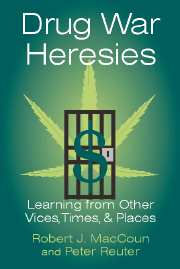Book contents
- Frontmatter
- Contents
- List of Figures and Tables
- Acknowledgments
- PART I OVERVIEW
- PART II THE ARGUMENTS
- 3 The Debate
- 4 Philosophical Underpinnings
- 5 How Does Prohibition Affect Drug Use?
- 6 How Does Prohibition Affect Drug Harms?
- PART III THE EVIDENCE
- PART IV ASSESSING THE ALTERNATIVES
- Bibliography
- Data Sources for Figures
- Author Index
- Subject Index
6 - How Does Prohibition Affect Drug Harms?
Published online by Cambridge University Press: 24 May 2010
- Frontmatter
- Contents
- List of Figures and Tables
- Acknowledgments
- PART I OVERVIEW
- PART II THE ARGUMENTS
- 3 The Debate
- 4 Philosophical Underpinnings
- 5 How Does Prohibition Affect Drug Use?
- 6 How Does Prohibition Affect Drug Harms?
- PART III THE EVIDENCE
- PART IV ASSESSING THE ALTERNATIVES
- Bibliography
- Data Sources for Figures
- Author Index
- Subject Index
Summary
The damage that drugs do to society is a function not only of the number of users but inter alia of the quantity they consume, the amount they spend, and the mode and circumstances of sales and consumption. For example, it is the income generated by drug sales rather than the quantity consumed that determines many of the problems associated with drug markets. Indeed, higher consumption at lower prices may reduce dealer earnings and related violence. Similarly, the fact that heroin is usually injected (partly a function of its extraordinarily high price) rather than snorted or smoked is the major factor linking heroin use and HIV; large numbers of heroin smokers might produce less harm than smaller numbers of injectors. All these harms are influenced by policy as implemented, particularly enforcement. This chapter examines that connection.
We begin by identifying the major harms associated with drugs under current policy. Not all harms are included. In particular, we do not consider the loss of liberty or of the possible benefits of drug use that loom large for some legalization advocates. It is not that we think those matters unimportant, as Chapters 4 and 13 make clear, but they are very much a matter of dispute and not susceptible to measurement.
The number of harms listed here (almost fifty) is daunting, but the elaboration is not mere pedantry. The harms are highly variegated and that variety is part of the policy problem, since it prevents effective aggregation and thus straightforward comparison of different regimes.
- Type
- Chapter
- Information
- Drug War HeresiesLearning from Other Vices, Times, and Places, pp. 101 - 127Publisher: Cambridge University PressPrint publication year: 2001



